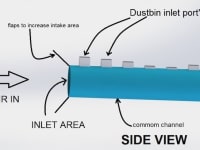Humans are polluting our environment. One of the phenomena is throwing garbage here and there while travelling in public transport like buses and trains. When people travel in buses and trains they tend to throw plastic-paper waste (plastic wrappers, coffee cups) either in the vehicle or outside the window which causes problem for cleaners, and it makes the city/surroundings filthy. Dustbins are not mobile plus they have limited capacity.
The proposed design is a DUSTBIN SYSTEM which solves the above problems. It consists of mostly hollow pipe like structures. Dustbin inlets will be provided next to every passenger seat. These inlets will be merged in a common collecting channel (placed along the edges, under the floor), which will be commonly connected to all other dustbin inlets. This garbage will be channeled to a common collecting dustbin which will be installed at the back of the vehicle.
Principle involved:
Gravity will play its role in moving the garbage along the inlet channel, now the garbage is in the common channel (vertical movement). Now, the question comes about the horizontal movement of the garbage in the common collecting channel. This is the innovative part of this project. Ordinary suggestions will be use of conveyor belt system or induced vacuum system. But as they will be increasing the system cost and causing complexity none of them is used. What we are using is the “relative air” which is moving in the opposite direction relatively to the vehicle movement. This relative air is channelized to drag the garbage from the open end to the common dustbin which is the last stage of collection.
If the system increases air drag and reduces the vehicles performance and efficiency, the air inlet for the common collecting channel can be designed such that it will open when the brakes of the vehicle are applied. Thus not only sweeping the garbage to the collecting bin but also subjecting the vehicle to an assistive drag which can prove as a helping hand in braking.
For buses the above system is good.
For trains, the aforementioned system will be designed to be compatible in bidirectional movement (for a single coach). Common collection dustbins will be placed on both the ends of the coach.
Also the system could be modified to collect heavy waste by making a slight bend in the horizontal common channel at the center. And adding a collection bin at the center (there is space under the trains). One train will contain multiple dustbin systems. (One will fit in each coach.)
Benefits:
Low cost of construction
Less maintenance
Will increase the labor productivity,
and obviously keep the city/environment clean.
If talking about economic viability:
Government and the vehicle manufacturers will be interested in this system.
I believe simple things can change the world.
Video
Like this entry?
-
About the Entrant
- Name:Amit Kumar
- Type of entry:individual
- Patent status:pending





